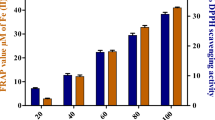Abstract
Fox nut or gorgon nut (Euryale ferox – Family Nymphaeaceae), popularly known as Makhana, has been widely used in traditional oriental medicine to cure a variety of diseases including kidney problems, chronic diarrhea, excessive leucorrhea and hypofunction of the spleen. Based on the recent studies revealing antioxidant activities of Euryale ferox and its glucosides composition, we sought to determine if Euryale ferox seeds (Makhana) could reduce myocardial ischemic reperfusion injury. Two different models were used: acute model, where isolated rat hearts were preperfused for 15 min with Krebs Henseleit bicarbonate (KHB) buffer containing three different doses of makhana (25, 125 or 250 μg/ml) followed by 30 min of ischemia and 2 h of reperfusion; and chronic model, where rats were given two different doses of makhana (250 and 500 mg/kg/day) for 21 days, after which isolated hearts were subjected to 30 min of ischemia followed by 2 h of reperfusion. In both cases, the hearts of the Makhana treated rats were resistant to ischemic reperfusion injury as evidenced by their improved post-ischemic ventricular function and reduced myocardial infarct size. Antibody array technique was used to identify the cardioprotective proteins. The Makhana-treated hearts had increased amounts of thioredoxin-1 (Trx–1) and thioredoxin-related protein-32 (TRP32) compared to the control hearts. Western blot analysis confirmed increased expression of TRP32 and thioredoxin proteins. In vitro studies revealed that Makhana extracts had potent reactive oxygen species scavenging activities. Taken together, the results of this study demonstrate cardioprotective properties of Makhana and suggest that such cardioprotective properties may be linked with the ability of makhana to induce TRP32 and Trx-1 proteins and to scavenge ROS.
Similar content being viewed by others
References
McGuffin M, Hobbs C, Upton R (eds): American products association's botanical safety handbook. Boca Raton, FL: CRC Press, 1997, pp51
Lee SE, Ju EM, Kim JH: Antioxidant activity of extracts from Euryale ferox seed. Exp Mol Med 34: 100–106, 2002
Zhao H, Zhao S, Sun C, Guillaume D: Glucosylsterols in extracts of Euryale ferox identified by high resolution NMR and mass spectroscopy. J Lipid res 30: 1633–1637, 1989
Normen L, Shaw CA, Fink CS, Awad AB: Combination of phytosterols and omega-3 fatty acids: A potential strategy to promote cardiovascular health. Current Med Cardiovasc Hematological Agents 2: 1–12, 2004
Das DK, Maulik N: Antioxidant effectiveness in ischemia-reperfusion tissue injury. Methods in Enzymology 233: 601–610, 1994
Engelman DT, Watanabe M, Engelman RM, Rousou JA, Kisin E, Kagan VE, Maulik N, Das DK: Hypoxic preconditioning preserves antioxidant reserve in the working rat heart. Cardiovasc Res 29: 133–140, 1995
Hattori R, Otani H, Maulik N, Das DK: Pharmacological preconditioning with resveratrol: Role of nitric oxide. Am J Physiol Heart Circ Physiol. 282: H1988–H1995, 2002
Ray PS, Maulik G, Cordis GA, Bertelli AA, Bertelli A, Das DK: The red wine antioxidant resveratrol protects isolated rat hearts from ischemia reperfusion injury. Free Radic Biol Med 27: 160–169, 1999
Mathur P, Kaga S, Zhan L, Das DK, Maulik N: Antibody array technique reveals overexpression of important DNA-repair proteins during cardiac ischemic preconditioning. J Mol Cell Cardiol 38: 99–102, 2005
Mathur P, Kaga S, Zhan L, Das DK, Maulik N: Potential candidates for ischemic preconditioning-associated vascular growth pathways revealed by antibody array. Am J Physiol 288: H3006–H3010, 2005
Sato M, Cordis GA, Maulik N, Das DK: SAPKs regulation of ischemic preconditioning. Am J Physiol Heart Circ Physiol 279: H901–H907, 2000
Maulik G, Maulik N, Bhandari V, Kagan VE, Pakrashi S, Das DK: Evaluation antioxidant effectiveness of a few herbal plants. Free Rad Res 27: 221–228, 1997
Das DK, Engelman RM, Rousou JA, Breyer RH, Otani H, Lemeshow S: Pathophysiology of superoxide radical as potential mediator of reperfusion injury in pig heart. Basic Res Cardiol 81:155–166, 1986
Das DK, Cordis GA: High performance liquid chromatographic detection of hydroxylated benzoic acids as indirect measure of hydroxyl radical in heart: Its possible link with the myocardial reperfusion injury. J Chromatogr 536: 273–282, 1991
Arner ESJ, Holmgren A: Physiological functions of thioredoxin and thioredoxin reductase. Eur J Biochem 267: 6102–6109, 2000
Nakamura H, Vaage J, Valen G, Padilla CA, Bjornstedt M, Holmgren A: Measurements of plasma glutaredoxin and thioredoxin in healthy volunteers and during open-heart surgery. Free Rad Biol Med 24: 1176–1186, 1998
Turoczi T, Chang VW, Engelman RM, Maulik N, Ho YS, Das DK: Thioredoxin redox signaling in the ischemic heart: An insight with transgenic mice overexpressing Trx1. J Mol Cell Cardiol Lee KK, Murakawa M, Takahashi S Tsubuki S, 35: 695–704, 2003
Kawashima S, Sakamaki K, Yonehara S: Purification, molecular cloning, and characterization of TRP32, a novel thioredoxin-related mammalian protein of 32 kDa. J Biol Chem 273: 19160–19166, 1998
Myrset AH, Bostad A, Jamin N, Lirsac PN, Toma F, Gabrielsen OS: DNA and redox state induced conformational changes in the DNA-binding domain of the Myb oncoprotein. EMBO J 12: 4625–4633, 1993
Matthews JR, Wakasugi N, Virelizier JL, Yodoi J, Hay RT: Thioredoxin regulates the DNA binding activity of NFkB by reduction of a disulphide bond involving cysteine 62. Nucleic Acids Res 20: 3821–3839, 1992
Maulik N, Sato M, Price BD, Das DK: An essential role of NFkB in tyrosine kinase signaling of p38MAPK regulation of myocardial adaptation to ischemia. Febs Lett 429: 365–369, 1998
Author information
Authors and Affiliations
Corresponding author
Additional information
This study was partially supported by NIH HL22559 and HL 33889. Excellent technical assistance of Praveer Mathur for antibody array is acknowledged.
Rights and permissions
About this article
Cite this article
Das, S., Der, P., Raychaudhuri, U. et al. The Effect of Euryale Ferox (Makhana), an Herb of Aquatic Origin, on Myocardial Ischemic Reperfusion Injury. Mol Cell Biochem 289, 55–63 (2006). https://doi.org/10.1007/s11010-006-9147-1
Received:
Accepted:
Published:
Issue Date:
DOI: https://doi.org/10.1007/s11010-006-9147-1




